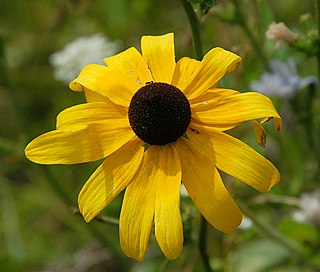
Rudbeckia hirta, commonly called black-eyed Susan, is a North American flowering plant in the family Asteraceae, native to Eastern and Central North America and naturalized in the Western part of the continent as well as in China. It has now been found in all 10 Canadian Provinces and all 48 of the states in the contiguous United States.

Xerochrysum bracteatum, commonly known as the golden everlasting or strawflower, is a flowering plant in the family Asteraceae native to Australia. Described by Étienne Pierre Ventenat in 1803, it was known as Helichrysum bracteatum for many years before being transferred to a new genus Xerochrysum in 1990. It is an annual up to 1 m (3.3 ft) tall with green or grey leafy foliage. Golden yellow or white flower heads are produced from spring to autumn; their distinctive feature is the papery bracts that resemble petals. The species is widespread, growing in a variety of habitats across the country, from rainforest margins to deserts and subalpine areas. The golden everlasting serves as food for various larvae of lepidopterans, and adult butterflies, hoverflies, native bees, small beetles, and grasshoppers visit the flower heads.
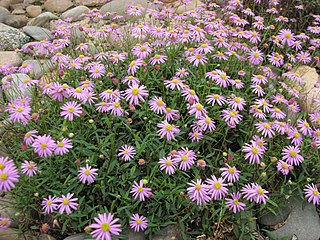
Brachyscome is a genus of flowering plants in the family Asteraceae. Most are endemic to Australia, and a few occur in New Zealand and New Guinea.

Brachyscome iberidifolia, the Swan River daisy, is an annual herb found in Western Australia. Occupying a wide range, the species spreads out as fields. The Bellis daisy form and colours were familiar to Europeans when discovered and they have since become a popular garden plant. Poor or sandy soils do not inhibit a showy display, the species is hardy and adaptable.

Symphyotrichum lateriflorum is a species of flowering plant in the aster family (Asteraceae). Commonly known as calico aster, starved aster, and white woodland aster, it is native to eastern and central North America. It is a perennial and herbaceous plant that may reach heights up to 120 centimeters and widths up to 30 cm (1 ft).

Gazania rigens, sometimes called treasure flower, is a species of flowering plant in the family Asteraceae, native to coastal areas of southern Africa. It is naturalised elsewhere and is widely cultivated as an ornamental plant.

Brachyscome ciliaris, commonly known as variable daisy, is a small bushy perennial herb with a prominent flower, which occurs throughout most of temperate Australia

Argyranthemum frutescens, known as Paris daisy, marguerite or marguerite daisy, is a perennial plant known for its flowers. It is native to the Canary Islands. Hybrids derived from this species are widely cultivated as ornamental plants in private gardens and public parks in many countries, and have naturalized in Italy and southern California. There are many cultivars, but the most common has white petals.

Celmisia spectabilis is one of the more widespread species in the mountainous areas of New Zealand, where it is commonly known as the cotton daisy. Belonging to the family Asteraceae, this species has leathery leaves that are ovate to lanceolate or narrowly oblong, and can reach 30 cm long. They have a shiny, green upper surface, with prominent parallel grooves, but their undersides are densely covered in soft, whitish or buff-coloured hairs. The leaf bases overlap and compact to form a stout pseudostem. Plants can form mats up to 2 m across.

Brachyscome multifida is a perennial herb in the family Asteraceae. Common names include cut-leaved daisy, rocky daisy, and Hawkesbury daisy. The species is endemic to Australia.
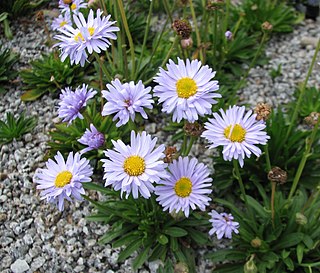
Brachyscome scapigera, commonly known as tufted daisy, is a perennial herb in the family Asteraceae. The species is endemic to south-eastern Australia.
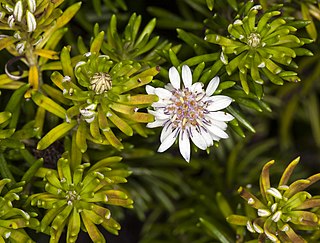
Olearia ballii, commonly known as mountain daisy, is a species of flowering plant in the family Asteraceae and is endemic to Lord Howe Island. It is a dense shrub with crowded linear leaves and small, purplish and white, daisy-like inflorescences.
Olearia mooneyi, commonly known as pumpkin bush, is a large shrub or small tree in the daisy family, Asteraceae. The specific epithet honours Thomas Mooney (1842–1873), an early settler of Lord Howe Island who was interested in its plants.
Senecio howeanus is an annual, or short-lived perennial, herb in the daisy family, Asteraceae. The specific epithet refers to the type locality.
Senecio pauciradiatus is an annual herb in the daisy family, Asteraceae. The specific epithet comes from the Latin pauci- (“few”) and radiatus, referring to the flower's relatively few ray florets.
Polystichum moorei is a fern in the family Dryopteridaceae. The specific epithet honours Charles Moore, Director of the Royal Botanic Gardens, Sydney, from 1848 to 1896, who collected plants on Lord Howe Island in 1869.

Brachyscome graminea, commonly known as grass daisy, is a perennial herb in the family Asteraceae and is endemic to Australia. It has mostly mauve-pink or purple daisy-like flowers and a yellow centre.
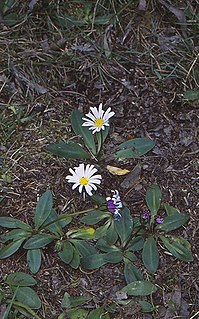
Brachyscome decipiens, commonly known as field daisy, is a perennial herb in the family Asteraceae and is endemic to Australia. It is a small herb with white or pale blue flowers.

Brachyscome dentata, commonly known as lobe-seed daisy, is a tufted perennial herb in the family Asteraceae and is endemic to Australia. It has mostly white or mauve daisy-like flowers, a yellow centre and pale green leaves. It is endemic to Australia.
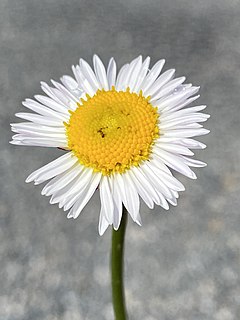
Brachyscome nivalis, commonly known as snow daisy, is a perennial herb in the family Asteraceae and is endemic to Australia. It has mostly white daisy-like flowers, yellow centres and deeply lobed leaves.
















